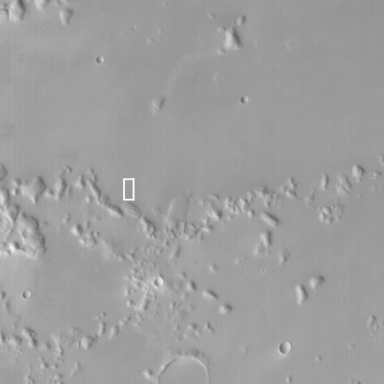











|
(MGS MOC Release No. MOC2-186, 22 October 1999)
 |
The white box in the picture to the left shows the location of one of the MOC images of possible psuedocraters on Mars. The white box is drawn upon a MOC red wide angle context image acquired at the same time as the high resolution view, shown at the top. Located in northwestern Amazonis Planitia near 24.8°N, 171.3°W, both the context image and high-resolution view are illuminated from the lower left. The high resolution view shows several possible psuedocraters (cone-shaped features with holes or pits at their summits) that occur on top of a rough-textured lava plain. The context frame covers an area 115 km (71 mi) across, the high-resolution view is 3 km (1.9 mi) across.
Pseudocraters form by explosions due to the interaction of molten lava with a water-rich surface. Possible martian pseudocraters are of interest because they may mark the locations of shallow water or ice at the time the lava was emplaced.
Viking Orbiter images have shown structures in other regions of Mars that were interpreted to be pseudocraters, but the interpretations were uncertain because the morphology was poorly resolved, it was unclear if they occurred on volcanic surfaces, and they have diameters as much as a factor of 3 larger than terrestrial pseudocraters. The cone-shaped morphology is well resolved in the cones imaged by MOC, and they have basal diameters of less than 250 m (273 yards), consistent with terrestrial examples. The cones rest on a surface with a distinctive morphology consisting of ridged plates that have rafted apart, which MOC team members have interpreted as the surface of voluminous lava flows.
The surface shown here (above right) looks relatively fresh and has very few impact craters on it, which suggests that the lava flows and the cones are both geologically young. However, MOC images in other areas reveal such apparently young surfaces being exhumed (presumably by wind erosion) from beneath a blanket of overlying material. Impact processes may harden the blanket, or cover it with materials that cannot be removed by wind, so the wind erosion leaves behind elevated "pedestal craters". The cones shown here are not typical of pedestal craters, but it is important to consider this alternative interpretation.
MGS MOC first began taking pictures of Mars in mid-September 1997. The planet that has been revealed by this camera is often strange, new, and exciting. The possibility that lava and water or ice have interacted to create features like psuedocraters indicates that Mars has had a diverse and complex past that researchers are only just begining to understand.
The pictures shown here are the subject of a talk on MOC views of volcanism on Mars being presented in an invited talk at the Geological Society of America (GSA) Annual Meeting in Denver, Colorado on Monday, October 25, 1999, by MOC scientist Alfred McEwen of the University of Arizona, Tucson.
Views of the Solar System Copyright © 1997-2000 by Calvin J. Hamilton. All rights reserved. Privacy Statement.